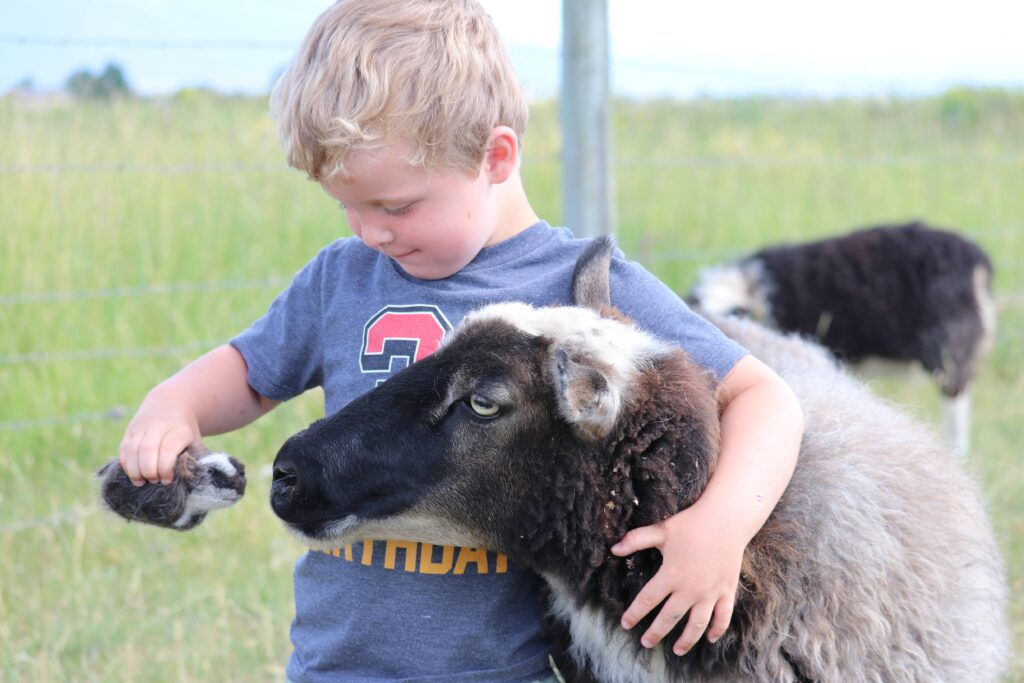As a mother and grandmother who has spent years tending to both little ones and sheep, I find immense joy in sharing the beauty of nature with children. One medium that has been fun to explore with them is using natural fibers like wool for weaving and felting. Join me as we embark on discovering and exploring the enriching world of offering things from nature and its profound impact on our children’s growth and development. In the gentle rhythm of our days, surrounded by our Icelandic sheep, we find ourselves drawn to the timeless art of weaving and felting with wool. As care takers of young children, we understand the profound importance of nurturing our children’s curious spirits and encouraging them to explore the wonders of the natural world. Wool offerings a perfect material to let your creativity flow through your fingers and into something of beauty.


Children are born with an innate sense of wonder—a boundless curiosity that yearns to be nourished and nurtured. By providing them with opportunities to create with natural materials and explore their surroundings, we empower them to embrace the world with open hearts and open minds. Whether they’re weaving a tapestry of dreams or sculpting with mud and clay, each moment of creative expression fosters a sense of confidence and self-discovery that will serve them well throughout their lives. Taking the time with children to look and listen to what nature has to offer can be an enriching time well spent. Make a list together of a new bird that is spotted in the neighborhood tree or take a walk together and identify the plants that are growing along the path. Perking a child’s interest to be aware and curious about what they are seeing a hearing is helping to develop lifelong skills of self discovery and being a student of life.

Years ago as a young mother I was draw to the philosophy of Steiner Waldorf. Being keenly aware of my children’s natural progression of development helped to provide experiences of curiosity and growth that did not overstimulate but supported where they were at cognitively. I read a book written by Rahima Baldwin “Your are your child’s first teacher; Encouraging your child’s natural development” that really helped give me tools as a mother to meet my child’s needs in a more intuitive way. At the heart of the Waldorf method lies a profound respect for the natural rhythms of childhood—a belief that children learn best when they are actively engaged in the world around them. By honoring the child’s physical development and nurturing their innate creativity, we lay the foundation for a lifetime of joyful learning. Through hands-on activities like weaving and woodworking, children learn not just with their minds, but with their hearts and hands, cultivating a deep connection to the world and all its wonders.
Something as simple as filling a cardboard box with oatmeal or rice for children to bury treasures, build roads or simple let the oatmeal sift through their fingers will give them opportunity for exploration and discovery.

Certainly, the benefits of children being around and interacting with animals, whether they are pets or farm animals, are numerous and well-documented. Studies have consistently shown that such interactions can have positive effects on children’s physical, emotional, and cognitive development.


Firstly, being around animals can promote empathy and compassion in children. Interacting with animals teaches them to be gentle, patient, and understanding, as they learn to care for the needs of another living being. This can lead to greater empathy not only towards animals but also towards other people, fostering kindness and respect for all living creatures.
Additionally, spending time with animals can have therapeutic effects on children’s mental health. Studies have found that interacting with animals can reduce stress, anxiety, and even symptoms of depression in children. The calming presence of animals, combined with the physical activity involved in caring for them, can help children regulate their emotions and develop coping skills to deal with life’s challenges. Watching our children and now our grandchildren developed relationships with specifically our sheep has been so sweet to watch. The sheep recognize the children coming out to the pasture with treat to give to them and they come running to greet the bearers of “good things”! . There is a trust that has been build that is rewarding.

Furthermore, being around animals can also promote physical activity and outdoor play. These activities encourage children to be active and engage with the natural world. This can have numerous health benefits, including improved cardiovascular health, better motor skills, and a stronger immune system.
Research suggests that children who grow up with pets are less likely to develop allergies and asthma. Exposure to pet dander and other allergens from an early age can help train the immune system to recognize and tolerate these substances, reducing the risk of allergic reactions later in life.
Overall, the bond between children and animals is a special and a valuable one, providing countless opportunities for learning, growth, and companionship. Whether it’s caring for a pet at home or spending time with farm animals in a rural setting, these interactions enrich children’s lives in profound and meaningful ways, shaping them into compassionate, resilient, and well-rounded individuals.

In our digital age, where screens dominate our lives, the importance of hands-on activities cannot be overstated. Working with their hands, whether it’s kneading dough or threading a needle, children engage all their senses and develop essential fine motor skills. As parents and grandparents, we have a unique opportunity to introduce our children to the joy of creating with their hands, instilling in them a sense of pride and accomplishment that comes from making something beautiful and meaningful with their own two hands. I have a basket of fabric and wool that is always available to them for a way of keeping their minds curious about what can be made with their hands and a little creativity. Baking cookies is a looked forward to activity that seems to lend it’s self to building sweet, lasting memories. The smell of those cookies baking will stay with those little ones into adulthood.

As we weave together the threads of tradition and innovation, let us not forget the importance of building meaningful relationships with our children and grandchildren. Let us look for and create opportunity to immerse ourselves in the beauty of nature or embark on creative projects together. Whether it’s a peaceful stroll through the meadows or woods, a shared moment at the loom, or simply watching the sheep graze in the fields, these experiences are not just about creating memories—they’re about strengthening the bonds that connect us across generations. So, let us embrace the wonders of nature and the joys of creativity, weaving a tapestry of love and connection that will endure for years to come.




